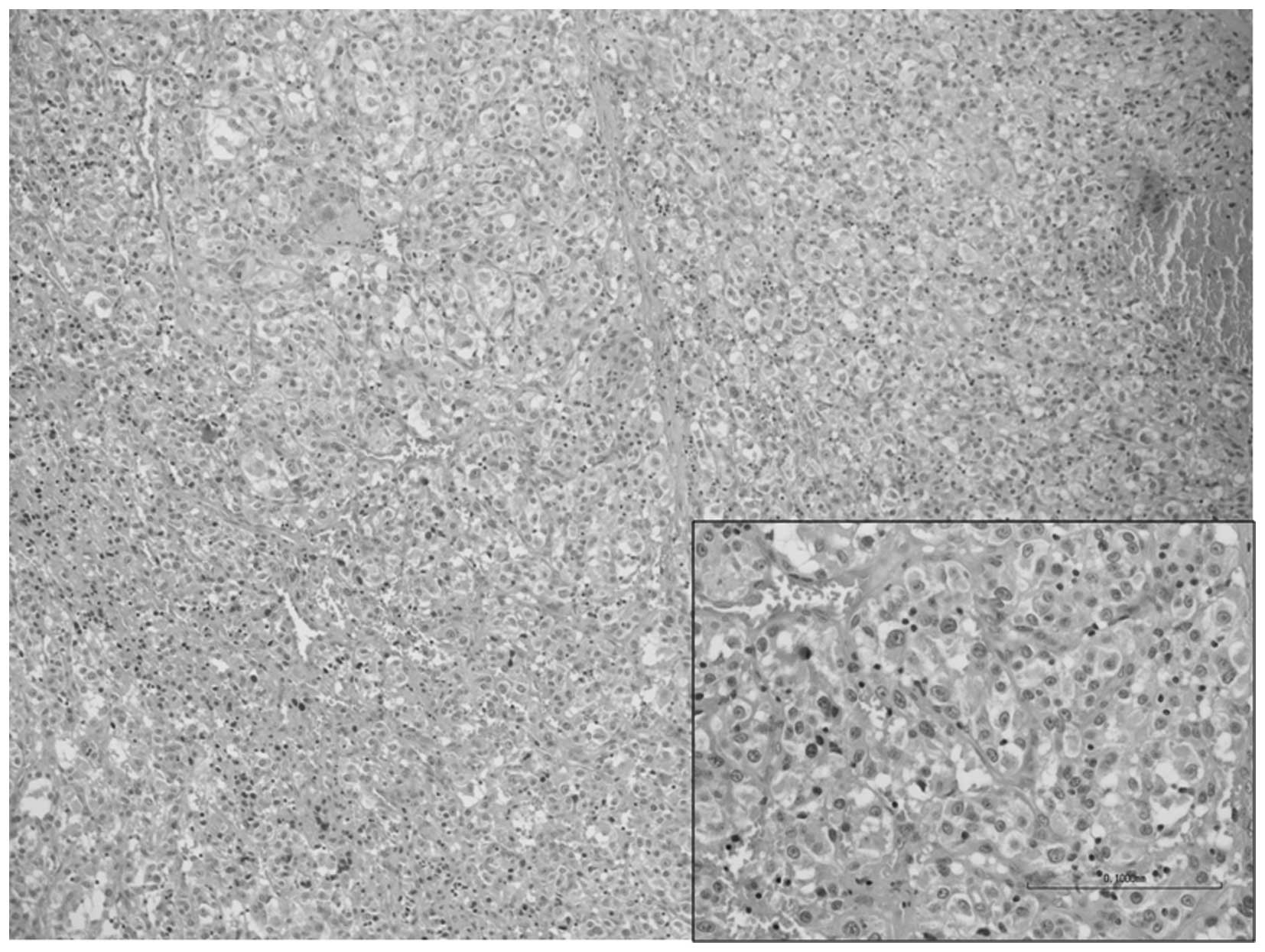|
1
|
Folpe AL: Neoplasms with perivascular
epithelioid cell differentiation (PEComas)World Health Organization
Classification of Tumors: Pathology and Genetics of Tumors of Soft
Tissue and Bone. Fletcher CDM. Unni KK and Mertens F: IARC Press;
Lyon: pp. 221–223. 2002
|
|
2
|
Martignoni G, Pea M, Reghellin D, Zamboni
G and Bonetti F: PEComas: The past, the present and the future.
Virchows Arch. 452:119–132. 2008. View Article : Google Scholar : PubMed/NCBI
|
|
3
|
Doyle LA, Hornick JL and Fletcher CD:
PEComa of the gastrointestinal tract: Clinicopathologic study of 35
cases with evaluation of prognostic parameters. Am J Surg Path.
37:1769–1782. 2013. View Article : Google Scholar : PubMed/NCBI
|
|
4
|
Hornick JL and Fletcher CD: PEComa: What
do we know so far? Histopathology. 48:75–82. 2006. View Article : Google Scholar : PubMed/NCBI
|
|
5
|
Napolioni V, Moavero R and Curatolo P:
Recent advances in neurobiology of Tuberous Sclerosis Complex.
Brain Dev. 31:104–113. 2009. View Article : Google Scholar : PubMed/NCBI
|
|
6
|
Kenerson H, Folpe AL, Takayama TK and
Yeung RS: Activation of the mTOR pathway in sporadic
angiomyolipomas and other perivascular epithelioid cell neoplasms.
Hum Pathol. 38:1361–1371. 2007. View Article : Google Scholar : PubMed/NCBI
|
|
7
|
Dickson MA, Schwartz GK, Antonescu CR,
Kwiatkowski DJ and Malinowska IA: Extrarenal perivascular
epithelioid cell tumors (PEComas) respond to mTOR inhibition:
Clinical and molecular correlates. Int J Cancer. 132:1711–1717.
2013. View Article : Google Scholar : PubMed/NCBI
|
|
8
|
Italiano A, Delcambre C, Hostein I, Cazeau
AL, Marty M, Avril A, Coindre JM and Bui B: Treatment with the mTOR
inhibitor temserolimus in patients with malignant PEComa. Ann
Oncol. 21:1135–1137. 2010. View Article : Google Scholar : PubMed/NCBI
|
|
9
|
Wagner AJ, Malinowska-Kolodziej I, Morgan
JA, Qin W, Fletcher CD, Vena N, Ligon AH, Antonescu CR, Ramaiya NH,
Demetri GD, et al: Clinical activity of mTOR inhibitor with
sirolimus in malignant perivascular epithelioid cell tumors:
Targeting the pathogenic activation of mTORC1 in tumors. J Clin
Oncol. 28:835–840. 2010. View Article : Google Scholar : PubMed/NCBI
|
|
10
|
Bunch K and Sunde J: Fertility sparing
treatment of a malignant uterine perivascular epithelioid cell
tumor: A case report. Gynecol Oncol Case Rep. 8:14–16. 2014.
View Article : Google Scholar : PubMed/NCBI
|
|
11
|
Benson C, Vitfell-Rasmussen J, Maruzzo M,
Fisher C, Tunariu N, Mitchell S, Al-Muderis O, Thway K, Larkin J
and Judson I: A retrospective study of patients with malignant
PEComa receiving treatment with sirolimus or temsirolimus: The
royal marsden hospital experience. Anticancer Res. 34:3663–3668.
2014.PubMed/NCBI
|
|
12
|
Gennatas C, Michalaki V, Kairi PV,
Kondi-Paphiti A and Voros D: Successful treatment with the mTOR
inhibitor everolimus in a patient with perivascular epithelioid
cell tumor. World J Surg Oncol. 10:1812012. View Article : Google Scholar : PubMed/NCBI
|
|
13
|
Oken MM, Creech RH, Tormey DC, Horton J,
Davis TE, McFadden ET and Carbone PP: Toxicity and Response
Criteria of the Eastern Cooperative Oncology Group. Am J Clin
Oncol. 5:649–655. 1982. View Article : Google Scholar : PubMed/NCBI
|
|
14
|
Agaimy A and Wünsch PH: Perivascular
epithelioid cell sarcoma (malignant PEComa) of the ileum. Pathol
Res Pract. 202:37–41. 2006. View Article : Google Scholar : PubMed/NCBI
|
|
15
|
Yanai H, Matsuura H, Sonobe H, Shiozaki S
and Kawabata K: Perivascular epithelioid cell tumor of the jejunum.
Pathol Res Pract. 199:47–50. 2003. View Article : Google Scholar : PubMed/NCBI
|
|
16
|
Parfitt JR, Keith JL, Megyesi JF and Ang
LC: Metastatic PEComa to the brain. Acta Neuropathol. 112:349–351.
2006. View Article : Google Scholar : PubMed/NCBI
|
|
17
|
Bergamo F, Maruzzo M, Basso U, Montesco
MC, Zagonel V, Gringeri E and Cillo U: Neoadjuvant sirolimus for a
large hepatic perivascular epithelioid cell tumor (PEComa). World J
Surg Oncol. 12:462014. View Article : Google Scholar : PubMed/NCBI
|













